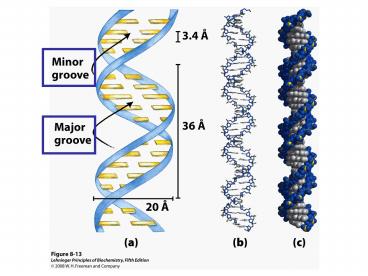Nucleotides and Nucleic Acids - PowerPoint PPT Presentation
1 / 40
Title:
Nucleotides and Nucleic Acids
Description:
Figure 5-15 UV absorbance spectra of native and heat-denatured E. coli DNA. How would YOU go about determining the mechanism of DNA replication????? – PowerPoint PPT presentation
Number of Views:362
Avg rating:3.0/5.0
Title: Nucleotides and Nucleic Acids
1
(No Transcript)
2
(No Transcript)
3
Binding of Proteins to DNA Often Involves
Hydrogen Bonding
Types of domains that bind DNA Helix-turn-helix
Zinc Finger Leucine Zipper Helix-loop-helix
4
(No Transcript)
5
AH bond acceptor DH bond donor
6
One of the most common DNA-protein interactions.
Because of its specific geometry of H-bond
acceptors, guanine can be unambiguously
recognized by the side chain of arginine
7
(No Transcript)
8
Helix-Turn-Helix Motif is Common in DNA-Binding
Proteins
- One of the helixes (red) fits into the major
groove of DNA - Four DNA-binding helix-turn-helix motifs (gray)
in the Lac repressor
9
Important Points a handshake leads to a bear-hug
Specific recognition of DNA targets by the
helix-turn-helix motif involves interactions
between sides of the recognition helix and bases
in the major groove of the DNA
But, specific recognition of DNA sequences is to
a large extent governed by other interactions
within complementary surfaces between the protein
and the DNA
These interactions frequently involve H-bonds
from protein main-chain atoms to the DNA backbone
in both the major and the minor groove and are
dependent on the sequence-specific deformability
of the target DNA
10
Lac repressor
11
Helix-turn-helix. (a) DNA-binding domain of the
Lac repressor
The helix-turn-helix motif is shown in red and
orange the DNA recognition helix is red.
12
Helix-turn-helix. (c) Surface rendering of the
DNA-binding domain of the Lac repressor bound to
DNA.
13
The DNA-binding domain separated from the DNA,
with the binding interaction surfaces
shown. groups on the protein and DNA that
interact through H-bonding groups that interact
through hydrophobic interactions
14
Zinc fingers 30 aas make a loop held together
by Zn ions
Three zinc fingers (gray) of the regulatory
protein Zif268, complexed with DNA (blue and
white). Each Zn2 coordinates with two His and
two Cys residues (not shown).
15
(No Transcript)
16
Leucine zippers
Leu (L) residues at every 7th position in the
zipper region, lots of Lys (K) and Arg (R)
residues in the DNA-binding region.
17
Helix-loop-helix
18
DNA Denaturation
- Covalent bonds remain intact
- Genetic code remains intact
- Hydrogen bonds are broken
- Two strands separate
- Base stacking is lost
- UV absorbance increases
Denaturation can be induced by high temperature,
or change in pH Denaturation may be
reversibleannealing
19
(No Transcript)
20
Figure 5-15 UV absorbance spectra of native and
heat-denatured E. coli DNA.
Page 90
21
Thermal DNA Denaturation (Melting)
- DNA exists as double helix at normal temperatures
- Two DNA strands dissociate at elevated
temperatures - Two strands re-anneal when temperature is lowered
- The reversible thermal denaturation and annealing
form basis for the polymerase chain reaction - DNA denaturation is commonly monitored by UV
spectrophotometry at 260 nm
22
(No Transcript)
23
Factors Affecting DNA Denaturation
- The midpoint of melting (Tm) depends on base
composition - high CG increases Tm
- Tm depends on DNA length
- Longer DNA has higher Tm
- Important for short DNA
- Tm depends on pH and ionic strength
- High salt increases Tm
24
(No Transcript)
25
Replication of Genetic Code
- Strand separation occurs first
- Each strand serves as a template
- for the synthesis of a new strand
- Synthesis is catalyzed by enzymes
- known as DNA polymerases
- Newly made DNA molecule has one
- daughter strand and one parent strand.
It has not escaped our notice that the specific
pairing we have postulated immediately suggests
a possible copying mechanism for the genetic
material Watson and Crick, in their
Nature paper,1953
26
(No Transcript)
27
How would YOU go about determining the mechanism
of DNA replication?????
- What would a geneticist do?
What would a biochemist do?
28
Figure 5-31 Action of DNA polymerases.
Page 99
29
Figure 5-32a Replication of duplex DNA in E. coli.
Page 100
30
Figure 5-32b Replication of duplex DNA in E. coli.
Page 100
31
Heres a computer modelhttp//www.youtube.com/wat
ch?v4jtmOZaIvS0
This is a pretty good outline http//www.youtube.
com/watch?vteV62zrm2P0NR1
- Overview of DNA and replication
- http//207.207.4.198/pub/flash/24/menu.swf
Another one with review questions http//www.wile
y.com/college/pratt/0471393878/student/animations/
dna_replication/index.html
32
Molecular Mechanisms of Spontaneous Mutagenesis
- Deamination
- Very slow reactions
- Large number of residues
- The net effect is significant 100 C ? U
- events /day in a mammalian cell
- Depurination
- N-glycosidic bond is hydrolyzed
- Significant for purines 10,000 purines
- lost/day in a mammalian cell
- Cells have mechanisms to correct most of these
modifications.
33
Some well-characterized nonenzymatic reactions of
nucleotides.
34
Some well-characterized nonenzymatic reactions of
nucleotides.
35
(No Transcript)
36
Molecular Mechanisms of Oxidative and Chemical
Mutagenesis
- Oxidative damage
- Hydroxylation of guanine
- Mitochondrial DNA is most susceptible
- Chemical alkylation
- Methylation of guanine
- Cells have mechanisms to correct most of these
modifications
37
(No Transcript)
38
Molecular Mechanisms of Radiation-Induced
Mutagenesis
- UV light induces dimerization of pyrimidines,
this may be the main mechanism for skin cancers - Ionizing radiation (X-rays and ?-rays) causes
ring opening and strand breaking. These are
difficult to fix - Cells can repair some of these modifications, but
others cause mutations. Accumulation of
mutations is linked to aging and carcinogenesis
39
(No Transcript)
40
Chapter 8 Summary
In this chapter, we learned about
- Function of nucleotides and nucleic acids
- Names and structures of common nucleotides
- Structural basis of DNA function
- Reversible denaturation of nucleic acids
- Chemical basis of mutagenesis































